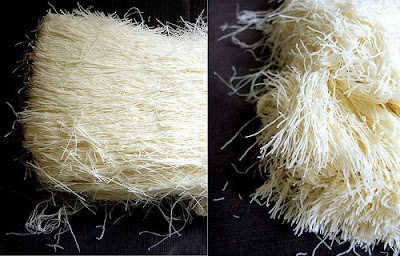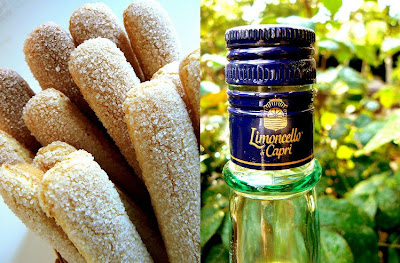 I was looking through Serious Eats the other day reading an amusing article entitled “Top 10 ingredients I will never have in my kitchen” where various readers had posted their own lists of items related to the subject. It was funny to see that quite a few had coriander (cilantro) amongst their top 10. I was just wondering how can someone NOT like coriander??? I love that stuff! And I used it recently in a dish I prepared coupling it up with veal (tis the good season for veal on this side of the world) and asparagus (good season for asparagus too!). While I was eating I thought to myself again, how can someone not like coriander?! Is it a cultural thing? I mean, we use it quite a lot in our Middle Eastern and Mediterranean cuisine and I would had never thought of, for instance, not using coriander for a lamb marinade, in meatballs or with fish.
I was looking through Serious Eats the other day reading an amusing article entitled “Top 10 ingredients I will never have in my kitchen” where various readers had posted their own lists of items related to the subject. It was funny to see that quite a few had coriander (cilantro) amongst their top 10. I was just wondering how can someone NOT like coriander??? I love that stuff! And I used it recently in a dish I prepared coupling it up with veal (tis the good season for veal on this side of the world) and asparagus (good season for asparagus too!). While I was eating I thought to myself again, how can someone not like coriander?! Is it a cultural thing? I mean, we use it quite a lot in our Middle Eastern and Mediterranean cuisine and I would had never thought of, for instance, not using coriander for a lamb marinade, in meatballs or with fish. Anyway, taking into account the anti-coriander movement, I am warning you from now: the recipe I’m posting today does contain coriander! Now for you coriander lovers out there, let me tell you that it went marvellously well with the veal, and overlapped nicely with the asparagus too. Because I’m a carbohydrate lover (carbs are not evil!) I also wanted to include some rice in this dish which I cooked following a method my mother has been using for years. It’s based on first frying angel hair until it turns golden before adding in the rice. I’ve always loved the colour fried angel hair can add to plain white rice- makes it look less boring I guess! Going a bit off-topic: in regards to the photos, unfortunately I am still struggling with lighting issues, and I wasn’t very lucky at the moment I was photographing this dish… nonetheless the most important is TASTE because as much as we eat with the eyes, our tastebuds deserve a treat too!
Anyway, taking into account the anti-coriander movement, I am warning you from now: the recipe I’m posting today does contain coriander! Now for you coriander lovers out there, let me tell you that it went marvellously well with the veal, and overlapped nicely with the asparagus too. Because I’m a carbohydrate lover (carbs are not evil!) I also wanted to include some rice in this dish which I cooked following a method my mother has been using for years. It’s based on first frying angel hair until it turns golden before adding in the rice. I’ve always loved the colour fried angel hair can add to plain white rice- makes it look less boring I guess! Going a bit off-topic: in regards to the photos, unfortunately I am still struggling with lighting issues, and I wasn’t very lucky at the moment I was photographing this dish… nonetheless the most important is TASTE because as much as we eat with the eyes, our tastebuds deserve a treat too! Above: frying the angel hair. Below: adding the rice and frying some more
Above: frying the angel hair. Below: adding the rice and frying some more
 Recipe for Veal with Coriander & Garlic, Angel Hair & Rice, Asparagus
Recipe for Veal with Coriander & Garlic, Angel Hair & Rice, AsparagusIngredients:
Veal (scallops)
Fresh coriander, chopped
Garlic, crushed
Green asparagus
Angel Hair
White rice (preferably basmati)
Olive oil
Salt & Pepper
How to make it:
Chop off the hard bits of the asparagus (the root-y bit). Optionally, you can cut off the triangular shaped leaflets too (keeping only the clustered ones at the top though- this is just for aesthetic purposes). Lay the asparagus in a pan, add hot water and let boil for about 6 minutes. In the meantime, drizzle and heat some olive oil in a pot. Then add some angel hair, let it become of a golden colour. Keep a close eye as angel hair can burn quite fast! Once it becomes golden, add the rice and stir for 1-2 minutes (basically you are frying angel hair and rice). Follow with water, cover pot, reduce heat and cook for about 10-15 minutes. With 5 minutes left to go for the rice, you can start with the veal. Drizzle and heat some olive oil in a pan, add the veal scallops on high heat first then reduce to lower heat for about 5 minutes (depends on how you like your veal). At the very end- and only at the very end- add the chopped coriander, crushed garlic, salt & pepper on high heat for about 1-2 minutes. You can also optionally add some cream too if you wish. Serve the veal with the angel hair & rice and asparagus- all at the right temperature.




































